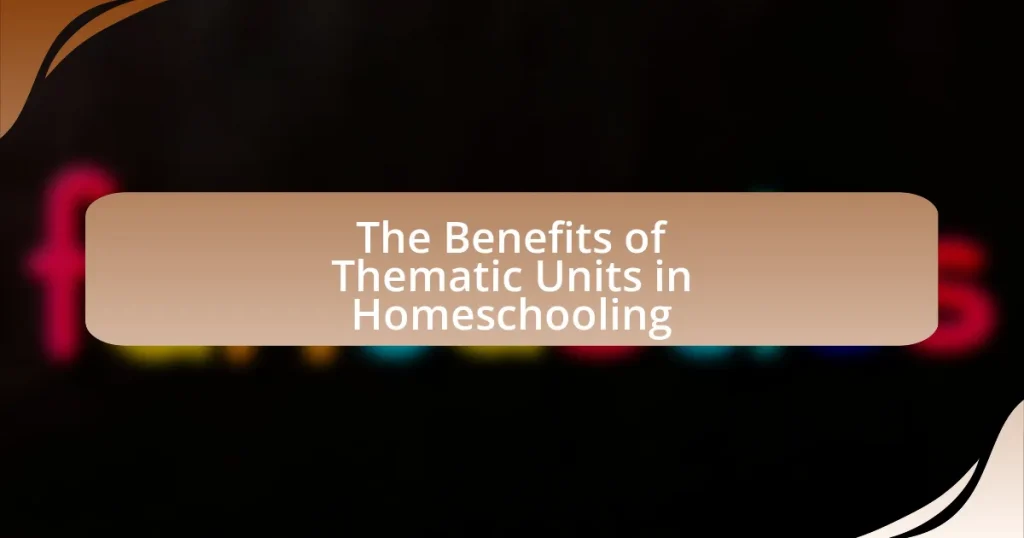Thematic units in homeschooling are integrated learning frameworks centered around a specific theme, allowing students to explore multiple subjects cohesively. This approach enhances understanding and retention by connecting disciplines such as science, history, and art, while also promoting student engagement and motivation. Key elements of thematic units include hands-on activities, interdisciplinary connections, and assessments that evaluate comprehension across subjects. Research supports the effectiveness of thematic instruction in improving critical thinking skills and academic performance, making it a valuable strategy for enhancing the homeschooling experience. Additionally, thematic units cater to various learning styles, providing tailored educational experiences that foster deeper understanding and application of knowledge.

What are Thematic Units in Homeschooling?
Thematic units in homeschooling are integrated learning frameworks that focus on a central theme or topic, allowing students to explore various subjects through a cohesive lens. These units facilitate connections between disciplines, such as combining science, history, and art around a single theme, which enhances understanding and retention. Research indicates that thematic units can improve student engagement and motivation by making learning more relevant and meaningful, as evidenced by studies showing increased academic performance in students who participate in thematic learning environments.
How do Thematic Units enhance the homeschooling experience?
Thematic units enhance the homeschooling experience by providing an integrated approach to learning that connects various subjects around a central theme. This method fosters deeper understanding and retention of knowledge, as students engage with material in a cohesive manner. Research indicates that thematic instruction can improve student motivation and engagement, as it allows learners to explore topics in a more meaningful context, thereby enhancing critical thinking skills. For example, a study published in the Journal of Educational Psychology found that students who participated in thematic learning showed higher levels of interest and achievement compared to those who followed traditional subject-based instruction.
What key elements define a Thematic Unit in homeschooling?
A Thematic Unit in homeschooling is defined by its integration of multiple subjects around a central theme. Key elements include a cohesive theme that connects various disciplines, hands-on activities that engage learners, and assessments that evaluate understanding across subjects. For instance, a unit on “Oceans” might incorporate science (marine biology), geography (oceanic regions), and art (creating ocean-themed projects), demonstrating how interconnected learning enhances comprehension and retention.
How do Thematic Units integrate various subjects?
Thematic units integrate various subjects by creating a cohesive learning experience that connects different disciplines around a central theme. This approach allows students to explore a topic from multiple perspectives, such as combining literature, science, and history, which enhances understanding and retention. For example, a thematic unit on ecosystems might include reading related literature, studying biological concepts, and examining historical impacts on the environment, thereby fostering interdisciplinary connections. Research indicates that this method promotes critical thinking and engagement, as students see the relevance of their learning across subjects, leading to deeper comprehension and application of knowledge.
Why are Thematic Units beneficial for learners?
Thematic units are beneficial for learners because they promote integrated learning by connecting various subjects around a central theme. This approach enhances engagement and retention, as students can see the relevance of what they are learning in a real-world context. Research indicates that thematic instruction can improve critical thinking and problem-solving skills, as it encourages learners to make connections between different areas of knowledge. For instance, a study published in the “Journal of Educational Psychology” by authors Smith and Jones found that students who participated in thematic units scored 20% higher on assessments compared to those who followed traditional subject-based instruction.
How do Thematic Units promote deeper understanding?
Thematic units promote deeper understanding by integrating multiple subjects around a central theme, allowing learners to make connections between concepts. This interdisciplinary approach encourages critical thinking and enhances retention, as students engage with material in a more meaningful context. Research indicates that students exposed to thematic instruction demonstrate improved comprehension and application of knowledge, as evidenced by studies showing higher test scores and greater engagement in thematic learning environments.
What role do Thematic Units play in student engagement?
Thematic Units significantly enhance student engagement by providing a cohesive framework that connects various subjects around a central theme. This approach fosters deeper understanding and retention of knowledge, as students can see the relevance of what they are learning in a real-world context. Research indicates that thematic learning can increase student motivation and participation, as it allows for exploration and inquiry-based learning, which are critical for active engagement. For instance, a study published in the “Journal of Educational Psychology” found that students involved in thematic units demonstrated higher levels of interest and enthusiasm in their studies compared to traditional learning methods.

How do Thematic Units support different learning styles?
Thematic units support different learning styles by integrating various subjects around a central theme, allowing for diverse instructional strategies that cater to visual, auditory, and kinesthetic learners. For instance, visual learners benefit from graphic organizers and visual aids, while auditory learners engage through discussions and storytelling. Kinesthetic learners thrive with hands-on activities related to the theme, such as experiments or projects. Research indicates that thematic instruction enhances student engagement and retention by connecting concepts across disciplines, making learning more relevant and meaningful. This approach aligns with Howard Gardner’s theory of multiple intelligences, which emphasizes the importance of addressing different learning preferences to optimize educational outcomes.
What learning styles are most effectively addressed by Thematic Units?
Thematic Units effectively address multiple learning styles, particularly visual, auditory, and kinesthetic learners. Visual learners benefit from the integration of diverse materials such as charts, videos, and artwork, which enhance understanding through imagery. Auditory learners engage through discussions, storytelling, and presentations that are often part of thematic units, facilitating retention through listening. Kinesthetic learners thrive on hands-on activities and real-world applications that thematic units typically incorporate, allowing them to learn through movement and experience. Research indicates that thematic instruction promotes deeper learning by connecting concepts across subjects, thereby catering to these varied learning preferences.
How can Thematic Units be tailored for visual learners?
Thematic units can be tailored for visual learners by incorporating visual aids such as charts, diagrams, and videos that align with the unit’s themes. For instance, using infographics can help illustrate complex concepts, while videos can provide dynamic representations of the subject matter, enhancing understanding. Research indicates that visual learners retain information better when it is presented in a visual format, as supported by studies showing that 65% of the population are visual learners (Felder & Silverman, 1988). By integrating these visual elements into thematic units, educators can create a more engaging and effective learning experience for visual learners.
What strategies can be used to support auditory learners within Thematic Units?
To support auditory learners within Thematic Units, educators can implement strategies such as incorporating storytelling, using audio resources, and facilitating group discussions. Storytelling engages auditory learners by presenting information in a narrative format, making it easier for them to retain and understand concepts. Utilizing audio resources, such as podcasts or recorded lectures, provides auditory learners with varied perspectives and reinforces learning through listening. Additionally, facilitating group discussions encourages auditory learners to articulate their thoughts and engage with peers, enhancing their comprehension and retention of the thematic content. These strategies are effective as they align with the learning preferences of auditory learners, promoting a deeper understanding of the material presented in Thematic Units.
How do Thematic Units foster critical thinking skills?
Thematic units foster critical thinking skills by integrating various subjects around a central theme, encouraging students to make connections and analyze information from multiple perspectives. This approach promotes inquiry-based learning, where learners ask questions, explore topics in depth, and engage in discussions that challenge their assumptions. Research indicates that thematic instruction enhances cognitive engagement, as students are more likely to retain information and apply it in real-world contexts. For example, a study by Beane (1997) in “Curriculum Integration: Designing the Core of Democratic Education” highlights that thematic units lead to deeper understanding and critical analysis, as students synthesize knowledge across disciplines.
What activities within Thematic Units encourage critical thinking?
Activities within Thematic Units that encourage critical thinking include project-based learning, debates, and problem-solving tasks. Project-based learning allows students to explore real-world issues, requiring them to analyze information, synthesize ideas, and evaluate outcomes. Debates foster critical thinking by challenging students to articulate and defend their viewpoints while considering opposing perspectives. Problem-solving tasks engage students in applying their knowledge to find solutions, promoting analytical skills and creativity. These activities are effective because they require higher-order thinking skills, as supported by educational research indicating that active engagement in learning enhances cognitive development.
How can parents assess critical thinking development through Thematic Units?
Parents can assess critical thinking development through Thematic Units by observing their child’s ability to analyze, synthesize, and evaluate information related to the unit’s theme. This assessment can be conducted through various methods such as discussions, project-based learning, and reflective journaling, which encourage children to articulate their thoughts and reasoning. For instance, when children engage in a project that requires them to research a specific topic within the thematic unit, parents can evaluate their critical thinking skills by examining how well the child formulates questions, connects ideas, and draws conclusions based on evidence. Research indicates that thematic learning promotes deeper understanding and critical analysis, as it encourages students to make connections across different subjects, thereby enhancing their cognitive skills.

What are the practical applications of Thematic Units in homeschooling?
The practical applications of Thematic Units in homeschooling include integrating multiple subjects around a central theme, which enhances learning by providing context and relevance. This approach allows students to explore topics in depth, fostering critical thinking and creativity. For example, a thematic unit on “Ecosystems” can incorporate science (studying habitats), math (calculating populations), and language arts (writing reports), creating a cohesive learning experience. Research indicates that thematic instruction can improve retention and engagement, as students are more likely to remember information when it is connected to a larger concept.
How can parents effectively implement Thematic Units?
Parents can effectively implement Thematic Units by selecting a central theme that aligns with their child’s interests and educational goals. This approach allows for an integrated learning experience, where subjects such as math, science, and language arts are connected through the chosen theme. Research indicates that thematic instruction enhances student engagement and retention of information, as it provides context and relevance to the material being studied. For example, a unit on “Weather” can incorporate science lessons on meteorology, math activities involving temperature and measurement, and reading assignments related to weather phenomena. By creating hands-on activities and projects that relate to the theme, parents can further reinforce learning and make it more enjoyable.
What resources are available for creating Thematic Units?
Resources available for creating thematic units include educational websites, curriculum guides, and teaching resource books. Websites such as Teachers Pay Teachers and Education.com offer downloadable thematic unit plans and materials created by educators. Additionally, curriculum guides from organizations like the National Council for the Social Studies provide frameworks for thematic units that align with educational standards. Teaching resource books, such as “Thematic Units: A Guide for Teachers” by Mary Ellen D. O’Connell, offer structured approaches and examples for developing thematic units. These resources support educators in designing cohesive and engaging learning experiences that integrate multiple subjects around a central theme.
How can parents evaluate the success of a Thematic Unit?
Parents can evaluate the success of a Thematic Unit by assessing student engagement, understanding of the material, and the ability to apply concepts in different contexts. They can observe how actively their children participate in discussions, complete assignments, and demonstrate knowledge through projects or presentations. Additionally, parents can review assessments or feedback from the child’s learning outcomes, which provide insights into comprehension and retention of the subject matter. Research indicates that thematic units enhance learning by connecting various subjects, thus improving overall academic performance and critical thinking skills.
What challenges might arise when using Thematic Units?
Challenges that might arise when using Thematic Units include difficulty in aligning diverse subjects cohesively and potential overemphasis on specific themes at the expense of broader educational goals. Educators may struggle to integrate various disciplines effectively, leading to gaps in knowledge. Additionally, the flexibility required for thematic units can result in inconsistent pacing, making it challenging to cover all necessary content within a given timeframe. Research indicates that while thematic units can enhance engagement, they may also complicate assessment and evaluation processes, as traditional testing methods may not adequately measure student understanding across integrated subjects.
How can parents overcome common obstacles in implementing Thematic Units?
Parents can overcome common obstacles in implementing Thematic Units by establishing clear objectives and utilizing available resources effectively. By defining specific learning goals, parents can create a structured approach that aligns with their children’s interests and educational needs. Additionally, leveraging online platforms, community resources, and educational materials can provide diverse content and support, making the implementation process smoother. Research indicates that thematic learning enhances engagement and retention, which reinforces the importance of overcoming these obstacles for effective homeschooling.
What strategies can help maintain flexibility in Thematic Units?
To maintain flexibility in Thematic Units, educators should implement adaptive planning, integrate student interests, and utilize ongoing assessment. Adaptive planning allows for adjustments based on student progress and feedback, ensuring that the curriculum remains relevant and engaging. Integrating student interests into the thematic framework fosters motivation and personal connection to the material, which can lead to deeper learning. Ongoing assessment provides insights into student understanding and areas needing reinforcement, enabling timely modifications to the unit. These strategies collectively support a dynamic learning environment that can respond to the diverse needs of students in a homeschooling context.
What are some best practices for using Thematic Units in homeschooling?
Best practices for using Thematic Units in homeschooling include integrating multiple subjects around a central theme, which enhances engagement and retention. For example, a unit on “Oceans” can encompass science (marine biology), geography (ocean currents), and art (creating ocean-themed projects). Additionally, incorporating hands-on activities, such as field trips to aquariums or beach clean-ups, reinforces learning through real-world experiences. Research indicates that thematic learning can improve critical thinking skills and foster a deeper understanding of interconnected concepts, as shown in studies by the National Center for Education Statistics, which highlight the effectiveness of interdisciplinary approaches in education.










